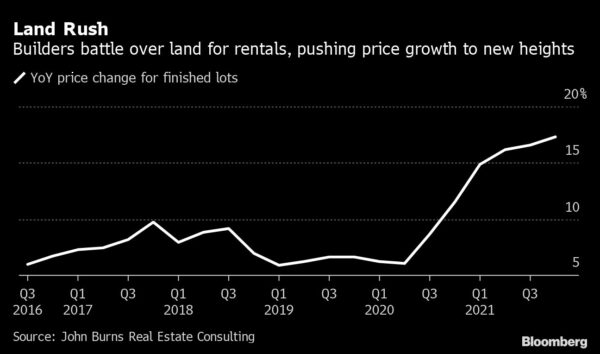By Prashant Gopal and Patrick Clark
For the U.S., the housing shortage is a crisis. For Wall Street, it’s a land rush.
Institutional investors from JPMorgan Chase & Co. and Morgan Stanley to the Arizona State Retirement System are pouring billions into their next big housing bet: building communities of single-family homes in the suburbs for renters getting priced out of homeownership.

Finding tenants is the easy part, as millennials with children, dogs and the need for remote-work space outgrow the confines of apartment living. But to succeed, landlords and their backers have to outcompete homebuilders for labor, materials and, most of all, land.
That’s contributing to skyward costs that are rippling through the market — meaning prices for newly built homes may climb even further out of reach for would-be buyers.
Single-family landlords, builders, apartment companies and institutional backers have committed $85 billion for build-for-rent projects, enough to develop 315,000 houses, according to Alan Ratner, an analyst at housing research firm Zelman & Associates. Only about 20% of the money has been spent and it’s already pushing up lot prices, he said. Two-thirds of land sellers surveyed by the firm late last year said for-sale builders are now going toe-to-toe with rental investors.
“You’ve got this new industry that’s cropped up overnight, backed by Wall Street,” Ratner said. “Very quickly the capital raised is competitive with the homebuilder universe.”
The shift to new construction is the next step in Wall Street’s bet that the American Dream will tilt more toward rentership. A decade ago, private equity firms helped stabilize housing in the wake of the financial crisis by scooping up foreclosures at fire-sale discounts and renting them to former homeowners with bad credit, an industry that rapidly grew and broadened in scope.
But now home listings are disappearing fast, prices are soaring and many investors prefer building rental communities from scratch over the inefficient process of buying existing houses, one by one, one bidding war to the next. Grouping houses closer together also makes them easier to manage, eliminating the need to deploy workers to single-family homes scattered across a wide geography.
“Investors are buying everything from finished homes to entitled land and anything you can imagine to get scale,” said Margaret Whelan, chief executive officer of Whelan Advisory Capital Markets, a boutique investment bank focused on homebuilders.
The business is so appealing that traditional homebuilders are diving in themselves. Lennar Corp. has teamed up with Centerbridge Partners and Allianz Real Estate to commit $4 billion to build and acquire purpose-built rentals. PulteGroup Inc., meanwhile, inked a deal to develop 7,500 houses for Invitation Homes Inc., the biggest single-family landlord in the U.S.
That means resources are getting diverted from the production of for-sale houses while at the same time helping to alleviate the rental shortage.
The effects are being seen in Sun Belt areas, where investors are most heavily concentrated, said T.A. “Kip” Hyde Jr., chief financial officer of Reeder Capital Partners, a Dallas-based family office with a land-development division that got a $100 million credit facility from Fortress Investment Group. He recently made an offer for a parcel in North Carolina for a homebuilder customer, only to see a build-for-rent company come in with an unsolicited bid of about 15% more.
“We have to go over this with the homebuilder with revised models and ask, ‘At what price are you out?’” Hyde said. “It’s inflationary — it translates into an increase in the home price for the end user.”Deals Accelerate
The build-for-rent market is small so far, with 14,000 houses under construction nationwide, according to data from listing service RentCafe. But it’s growing fast: Nationally, about 6% of finished lots purchased in the fourth quarter were for rental-house projects, up from 3% a year earlier, data from John Burns Real Estate Consulting show. In the Southeast, which includes hot spots in the Carolinas, Tennessee and Georgia, the share was 14%.
The price of lots across the country jumped 17% in the fourth quarter, more than double the annual pace of growth two years earlier.
Until the second half of last year, it wasn’t penciling out for single-family rental companies to pay a premium for lots, said Greg Vogel, chief executive officer of Land Advisors Organization in Scottsdale, Arizona, which brokered $4.4 billion in land transactions in 2021. Then rental demand went through the roof, fueled by pandemic moves and soaring prices in the for-sale market.
Rents for U.S. single-family homes jumped by a record 12% in November, three times the annual growth pace a year earlier, according to data from CoreLogic. They surged 33% in Miami and almost 20% in Phoenix.
“This is just math and the math is beginning to prove they can pay more,” Vogel said.

Mark Wolf, a pioneer in the build-for-rent business who founded his now San Antonio, Texas-based AHV Communities in 2013, said the big-money newcomers are making aggressive bids. Their cottage-style projects, in particular, squeeze more homes onto the same acreage, allowing them to pay more for land.
It’s a mistake to discount the risk of a future rent pullback, Wolf said.
“They’re putting these homes 30 or 40 minutes outside town,” he said. “It’s irrational exuberance to assume if you build it, they will rent it.”
Jordan Kavana, CEO of rental company Transcendent Electra, said firms like his can approach land acquisition differently than for-sale builders. It takes time to complete communities of homes, which the company plans to own and operate for years. So it’s better to stockpile land before it goes even higher. Earlier this month, his firm reached a $1.25 billion deal to acquire lots in Florida, Georgia and North Carolina.
“It’s a land-constrained market and we’ve seen values go up,” Kavana said. “We may be able to pay more, because we’re long-term holders.”
Investors betting on rentals have another reason to be bullish: The Federal Reserve’s march to raise interest rates may squeeze already-pinched homebuyers and stall the for-sale market.
“As mortgage rates rise over the next year, the monthly payment will go meaningfully higher, pricing more young families out of homeownership,” said Brad Hunter, a housing economist who advises large-scale developers on land purchases. “And the option of renting a brand-new single-family home in a professionally managed, cohesive subdivision will become that much more attractive.”
More stories like this are available on bloomberg.com




